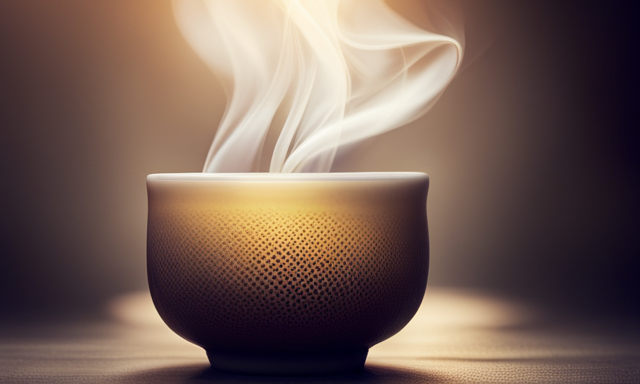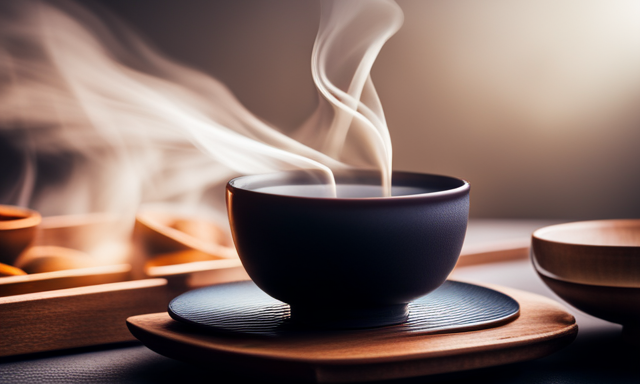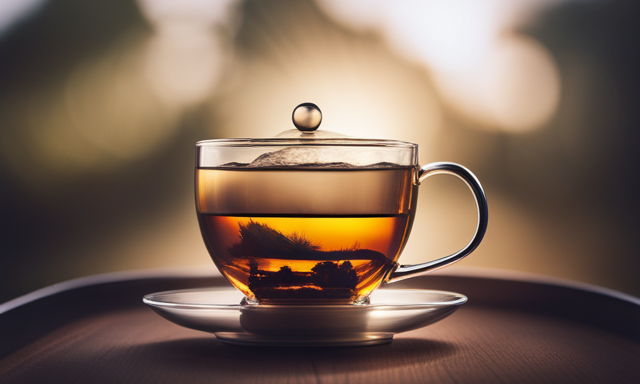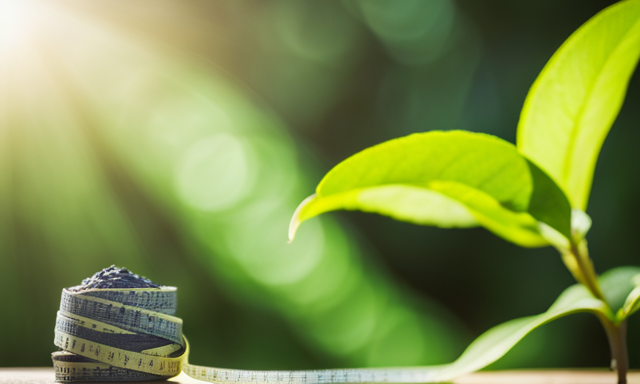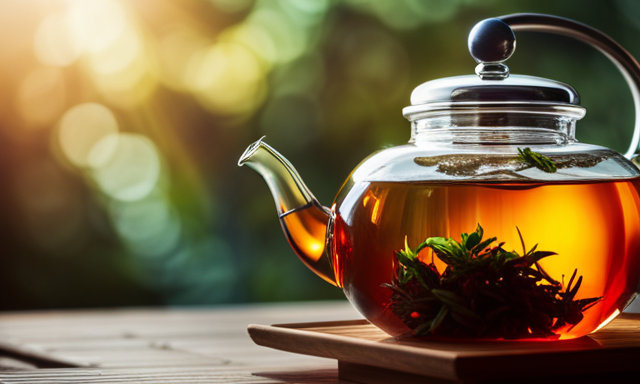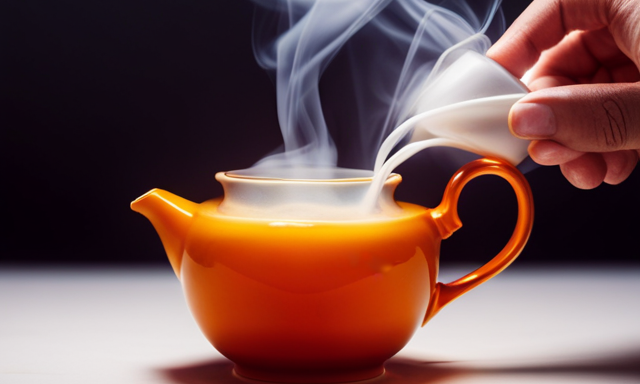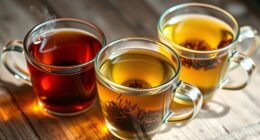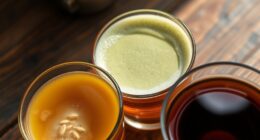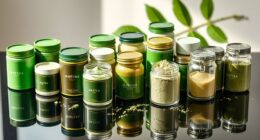Like a warm embrace on a chilly morning, a cup of oolong tea has the power to awaken my senses and soothe my soul. The delicate aroma and rich flavor of this traditional Chinese tea have made it a beloved choice for tea enthusiasts around the world.
But when it comes to brewing the perfect cup, one question often arises: how much oolong tea per cup? As an avid tea lover, I have delved into the depths of oolong tea knowledge to uncover the secrets behind achieving the ideal strength and flavor.
In this article, I will guide you through the various factors that affect the taste of your oolong tea, help you determine your personal preference, and provide recommendations for different cup sizes.
So, grab your favorite tea infuser or strainer, and let’s embark on a journey to unlock the full potential of oolong tea.
Key Takeaways
- The general rule is 2 grams of tea per 8-ounce cup of water.
- Adjust the amount based on personal preference.
- Proper measurement ensures a balanced cup of oolong tea.
- Use approximately one teaspoon of tea leaves per cup of water.
Types of Oolong Tea
Let’s talk about the different types of oolong tea you can enjoy.
When it comes to oolong tea, the water temperature and steeping techniques play a crucial role in determining the flavor and strength of your cup.
Oolong tea is known for its wide range of flavors, which can vary from light and floral to rich and roasted.
Some popular types of oolong tea include Tie Guan Yin, Da Hong Pao, and Oriental Beauty.
Each type requires a specific water temperature for steeping to bring out its unique characteristics. For example, Tie Guan Yin is best brewed at around 190°F, while Da Hong Pao requires a higher temperature of 212°F.
By understanding the different types of oolong tea and their optimal steeping techniques, you can truly appreciate the nuances and complexities of this wonderful beverage.
Now, let’s delve into the factors that affect the flavor and strength of oolong tea.
Factors Affecting Flavor and Strength
When it comes to brewing a perfect cup of oolong tea, there are two key factors that can greatly affect its flavor and strength. These factors are water temperature and steeping time, and tea-to-water ratio.
The water temperature plays a crucial role in extracting the right amount of flavors from the tea leaves. If the water is too hot, it can result in a bitter and astringent brew. On the other hand, if the water is too cool, it may not extract enough flavors, resulting in a weak and bland cup of tea.
The steeping time determines the strength of the brew. A longer steeping time will result in a stronger and more robust flavor, while a shorter steeping time will produce a milder and lighter cup of tea. It is important to find the right balance and adjust the steeping time according to personal preference.
Additionally, finding the right balance between the amount of tea leaves and water used is essential for achieving the desired taste. Using too many tea leaves can result in an overpowering and bitter brew, while using too few leaves may result in a weak and watery cup of tea.
By carefully controlling these factors – water temperature, steeping time, and tea-to-water ratio – you can brew a perfect cup of oolong tea that is full of flavor and has the desired strength.
Water temperature and steeping time
For the perfect cup of oolong tea, steep it just long enough to let the flavors dance and the water temperature sing.
Water temperature plays a crucial role in bringing out the best flavors in oolong tea. Different oolong teas require different water temperatures for optimal steeping. Generally, lighter oolong teas should be steeped at lower temperatures, around 170-180°F (77-82°C), while darker oolong teas can handle higher temperatures, around 190-200°F (88-93°C).
The brewing technique also affects the flavor and strength of the tea. Steeping oolong tea for too long or at too high a temperature can result in a bitter taste, while steeping it too short may result in a weak flavor. Achieving the right balance between water temperature and steeping time is key to unlocking the full potential of oolong tea.
As we move on to discussing the tea-to-water ratio, it is important to maintain this delicate balance to enjoy a truly delightful cup of oolong tea.
Tea-to-water ratio
To achieve the perfect cup of oolong tea, ensure you have the right balance between the amount of tea leaves and water. The tea-to-water ratio plays a crucial role in determining the tea strength and flavor. Too much tea leaves can result in a strong, overpowering brew, while too little may lead to a weak and insipid cup. Finding the ideal ratio can be a matter of personal preference, but a general guideline is to use 2 to 3 grams of tea leaves for every 8 ounces (240 mL) of water. However, some oolong teas may require more or less depending on their leaf size and processing. Experimenting with different ratios and brewing techniques will help you determine your personal preference and find the perfect balance of flavors. Transitioning to the next section about determining your personal preference, it is important to explore various brewing methods and find what suits your taste buds best.
Determining Your Personal Preference
Discovering your personal preference for oolong tea can be an exciting journey, as you explore the perfect amount to brew per cup. When it comes to personal preferences, experimenting with flavors is key. Here are five factors to consider as you determine your ideal oolong tea strength:
- Leaf size: Larger leaves often require more tea per cup to extract the desired flavor.
- Tea type: Different oolong teas have varying levels of intensity, so adjust the amount accordingly.
- Steeping time: Longer steeping times can result in stronger flavors, so adjust the tea-to-water ratio accordingly.
- Water temperature: Higher temperatures can enhance the tea’s flavor, so you may need to use more tea to balance the taste.
- Personal taste: Ultimately, it all comes down to your personal preference and the strength of flavor you desire.
As you delve into the world of oolong tea, these considerations will help you find the perfect balance.
In the next section, I will provide recommendations for different cups of oolong tea, guiding you towards the best brewing techniques.
Recommendations for Different Cups of Oolong Tea
Embark on a flavor-filled journey as I guide you towards the perfect brewing techniques for various cups of oolong tea.
When determining steeping time for oolong tea, it’s important to consider the type and quality of the tea leaves. Lighter oolong teas, such as green oolong, generally require a shorter steeping time of around 3-5 minutes, while darker oolongs, like roasted oolong, may need a longer steeping time of 5-7 minutes.
Additionally, the water temperature plays a crucial role in bringing out the flavors of oolong tea. For lighter oolongs, a water temperature between 160-180°F is recommended, while darker oolongs benefit from slightly hotter water between 190-205°F. So, finding the perfect balance between steeping time and water temperature is key to unlocking the full potential of oolong tea.
Now, let’s move on to using a tea infuser or strainer for the best brewing experience.
Using a Tea Infuser or Strainer
When it comes to using a tea infuser or strainer, it’s important to choose the right one for your needs. Whether you prefer a stainless steel infuser or a silicone strainer, finding the one that fits your tea brewing routine is key.
Additionally, properly measuring and steeping the tea is crucial for achieving the perfect cup. Be sure to follow the recommended measurements and steeping times to extract the full flavor and aroma of your oolong tea.
Choosing the right infuser or strainer
To brew a perfect cup of oolong tea, it’s important to find the right infuser or strainer that suits your personal taste.
When choosing the right teapot, consider the size and material. A larger teapot allows the leaves to expand fully, resulting in a more flavorful brew. As for the material, ceramic or glass infusers are preferred as they don’t affect the taste of the tea.
Once you’ve found the perfect infuser, it’s essential to clean it properly. Rinse it with warm water after each use and use a soft brush to remove any residual tea particles. This ensures that your tea doesn’t acquire any unwanted flavors.
Now that you have the perfect infuser, let’s move on to properly measuring and steeping the tea, ensuring a delightful cup every time.
Properly measuring and steeping the tea
Get ready to embark on a delicious journey as you learn the art of properly measuring and steeping your tea, allowing the flavors to dance and mingle like a well-choreographed ballet.
When it comes to measuring techniques, accuracy is key. To ensure a perfectly balanced cup of oolong tea, use a kitchen scale to measure the precise amount of tea leaves needed. The general rule of thumb is 2 grams of tea per 8-ounce cup of water. However, you can adjust the amount based on your personal preference for a stronger or milder brew.
As for steeping equipment, a good quality infuser or strainer is essential. Look for one with fine mesh to prevent any leaves from escaping into your cup.
With the proper measuring techniques and steeping equipment, you are now ready for the next section, where I will share tips for brewing the perfect cup.
Tips for Brewing the Perfect Cup
For the perfect cup of oolong tea, you’ll want to use just the right amount of tea leaves per cup. Properly measuring and steeping the tea is crucial to achieve the desired flavor profiles and to fully enjoy the rich taste of oolong tea.
When it comes to brewing techniques, it’s important to remember that oolong tea leaves expand during steeping, so it’s best to use approximately one teaspoon of tea leaves for every cup of water. This will allow the leaves to unfurl and release their flavors properly.
Additionally, the brewing time can vary depending on the type of oolong tea you’re using, so be sure to follow the recommended steeping instructions. By incorporating these tips, you’ll be on your way to brewing the perfect cup of oolong tea and enhancing its delightful flavor.
Enhancing the Flavor of Oolong Tea
When it comes to enhancing the flavor of oolong tea, I find that adding natural sweeteners or flavors can elevate the taste profile. Personally, I enjoy a touch of honey or a slice of fresh lemon to bring out the unique characteristics of the tea.
Additionally, pairing oolong tea with complementary snacks or meals can create a delightful experience. Whether it’s enjoying a cup of floral oolong with a light fruit salad or a rich and roasted oolong with dark chocolate, the combination of flavors can truly enhance the overall enjoyment of the tea.
Adding natural sweeteners or flavors
To enhance the delightful taste of your oolong tea, try adding a touch of natural sweeteners or flavors for an extra burst of flavor. There are several options to consider:
- Honey: A drizzle of honey adds a subtle sweetness that complements the earthy notes of oolong tea.
- Citrus zest: Grate some lemon or orange zest into your tea to infuse it with a refreshing citrusy flavor.
- Fresh herbs: Experiment with herbs like mint, basil, or lavender to add an aromatic twist to your cup of tea.
- Fruit slices: Add slices of fresh fruit like strawberries, peaches, or apples for a hint of natural sweetness.
- Spices: Sprinkle a pinch of cinnamon, cardamom, or ginger to add warmth and depth to your oolong tea.
By incorporating these natural sweeteners and flavors, you can create a personalized oolong tea blend that suits your taste preferences.
Now, let’s explore how to pair oolong tea with complementary snacks or meals.
Pairing oolong tea with complementary snacks or meals
Enhance your oolong tea experience by discovering the perfect snacks or meals to pair with it. When it comes to complementary tea pairings, oolong tea offers a wide range of options.
Its unique flavor profile, which can be floral, fruity, or even toasty, makes it a versatile beverage that pairs well with various foods.
For a light and refreshing pairing, try pairing oolong tea with fresh fruits like berries or citrus slices. The natural sweetness of the fruits complements the subtle flavors of the tea.
If you prefer a more savory option, oolong tea goes well with light snacks like nuts or cheese. The tea’s earthy undertones harmonize with the rich flavors of these foods.
Additionally, oolong tea benefits from being paired with spicy or savory dishes, as it helps cleanse the palate and balance out the flavors.
In the next section about storing oolong tea properly, we will discuss the importance of maintaining its freshness.
Storing Oolong Tea Properly
To store oolong tea properly and maintain its flavor, follow these guidelines:
- Use an airtight container to preserve freshness.
- Prevent the tea leaves from absorbing other odors by storing them separately.
- Protect the delicate flavor by avoiding exposure to air, light, and moisture.
- Maintain quality over time by creating a protective barrier with an airtight container.
- Store the container in a cool, dry place away from direct sunlight.
- Preserve the tea’s delicate aroma and taste by following these simple storage guidelines.
By following these steps, you can ensure that your oolong tea stays fresh and flavorful for an extended period. Now, let’s explore the art of gongfu tea ceremony.
The Art of Gongfu Tea Ceremony
Let’s dive into the fascinating world of the Gongfu Tea Ceremony, where every sip becomes a mesmerizing journey of flavors and aromas. The Gongfu Tea Ceremony, also known as the Chinese Tea Ceremony, has a rich history that dates back centuries. It originated in the Fujian province of China and has since become a beloved tradition among tea enthusiasts worldwide.
During the Gongfu Tea Ceremony, precision and technique are key. The tea leaves are carefully selected and steeped in small clay teapots called Yixing teapots. These teapots are specifically designed to enhance the flavor and aroma of the tea. The water temperature, steeping time, and number of infusions are meticulously controlled to extract the best qualities from the tea leaves.
To give you a glimpse of the ceremony, here is a table showcasing some Gongfu Tea Ceremony techniques:
| Technique | Description |
|---|---|
| Rinse | Pour hot water over the tea leaves to awaken their flavors. |
| First Infusion | Steep the tea leaves for a short time to extract their essence. |
| Second Infusion | Increase the steeping time to further develop the flavors. |
| Subsequent Infusions | Continue steeping the tea leaves, enjoying the evolving flavors. |
Now that we’ve explored the art of the Gongfu Tea Ceremony, let’s delve into the health benefits of oolong tea.
Oolong Tea and Health Benefits
Immerse yourself in the world of oolong tea and discover the myriad of health benefits that await you with each fragrant and invigorating sip. Oolong tea, known for its unique flavor and aroma, has been enjoyed for centuries and is renowned for its positive effects on weight loss and skin health. Here are five reasons why oolong tea should be a part of your daily routine:
- Boosts metabolism: Oolong tea contains polyphenols that help increase metabolism, aiding in weight loss.
- Burns fat: The catechins in oolong tea activate enzymes that help burn stored fat, promoting weight loss.
- Enhances skin health: The antioxidants in oolong tea help protect the skin from damage caused by free radicals, promoting a youthful complexion.
- Improves digestion: Oolong tea aids in digestion and helps regulate blood sugar levels, promoting a healthy gut.
- Reduces inflammation: The anti-inflammatory properties of oolong tea can help reduce inflammation in the body, benefiting overall health.
Incorporating oolong tea into your daily routine can provide you with a delicious way to support weight loss and maintain healthy skin.
Frequently Asked Questions
Can I use oolong tea bags instead of loose leaf tea?
Yes, oolong tea bags can be steeped for longer, but it is important to follow the recommended steeping time. The quality of oolong tea bags may vary compared to loose leaf tea, but it depends on the brand and the specific tea.
How long should I steep oolong tea to get the best flavor?
To achieve the best flavor profile for oolong tea, steep it for around 3-5 minutes. This will allow the leaves to release their complex aromas and flavors without becoming overly bitter.
Can I reuse oolong tea leaves for multiple cups?
Yes, you can reuse oolong tea leaves for multiple cups. This not only helps to maximize the flavor but also provides additional health benefits as oolong tea is rich in antioxidants and can aid in weight management and heart health.
Is oolong tea suitable for cold brewing?
Yes, oolong tea is suitable for cold brewing. It retains its health benefits, such as boosting metabolism and promoting heart health. Its flavor profiles can range from floral to fruity, making it a refreshing and delicious choice for cold brewing.
How does the water temperature affect the taste of oolong tea?
Water temperature greatly affects the taste of oolong tea. Different temperatures bring out different flavors. To achieve a balanced taste, steeping at 190-200°F for 3-5 minutes is recommended. Experiment with brewing techniques to find your preferred flavor profile.
Conclusion
In conclusion, finding the perfect amount of oolong tea per cup is a personal journey. It depends on the type of oolong tea you’re using, your personal preference for flavor and strength, and the size of your cup.
Experiment with different amounts and brewing times to discover your ideal cup of oolong tea.
Remember, oolong tea offers not only a delightful taste but also numerous health benefits. So, don’t hesitate to indulge in this exquisite tea, and let its soothing embrace transport you to a state of blissful tranquility.

